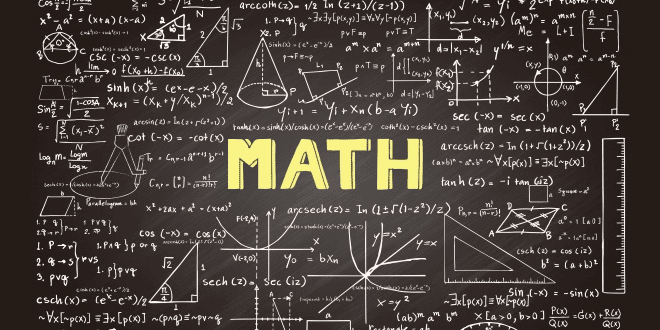8th Mathematics Annual Exam (2018-19)
Time: 3 hour
M.M. 80 marks
Date: 05/02/2019
Subject: Mathematics
Class: VIII
General Instructions:
- All questions are compulsory.
- Do you work neatly.
- Do not scribble on the question paper.
- Write your name and section on the question paper.
Section A [1×6 = 6]
Question: 1. Identify the variance: Number of people and fixed quantity of food that will last.
Question: 2. Find the number of sides of a regular polygon if the measure of each exterior angle is 60°.
Question: 3. If one the diagonal of a square is 10 cm, find the area of the square.
Question: 4. Write down the abscissa and ordinate of the point P (-3, 5).
Question: 5. Factorize: x² – 8x + 16.
Question: 6. Find the curved surface area of a cubical water tank of side 2.1 m.
Section B [2×10 = 20]
Question: 7. A table marked at Rs. 20,000 is available at Rs. 18,000. Find the discount given on the table and the discount percentage.
Question: 8. In how much time will Rs. 5000 amount to Rs. 6655 at 10% p.a. compounded annually?
Question: 9. If the length and breadth of a rectangle are (x² – 5x + 3) units and (5x – 2) units respectively, find its area.
Question: 10. Factorize: 6a² 17a + 12.
Question: 11. A metallic pipe whose internal and external radius are 3 cm and 4 cm has a length of 1.1 m. Find the volume of the metal used.
Question: 12. Construct a parallelogram whose adjacent sides are 7 cm and 5 cm with 70º as included angle.
Question: 13. If 9 men can mow a field in 4 days, in how many days can 6 men mow the same field?
Question: 14. If the altitude of parallelogram is doubled and base is halved, what happens to the area?
Question: 15. Plot the points A (-1,3), B (0,2), C (1,1) and D (2,0). Are the points co-linear?
Question: 16. In the figure given below, PQRS is a Rhombus, state the length of PQ and ∠Q. Give reasons.
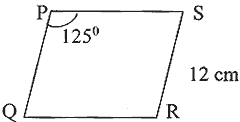
Section C [3×10 = 30]
Question: 17. Rajneesh sold her watch at a profit of 7%. If he has sold it for Rs. 294 more, he would have got a 10% profit. Find the cost price of the watch.
Question: 18. A shopkeeper was selling all his items at 25% discount. During the off – season, he offered 20% discount over and above the existing discount. If Surveer bought a washing machine, which was marked Rs. 20,000, how much did she pay for it?
Question: 19. A field is in the form of a kite. Its perimeter is 200m. If one of its sides is 40m, what are the lengths of the other two sides of the field?
Question: 20. Find the product using suitable identities. Also, mention the identities used.
(a) 99³ (b) 105 × 106
Question: 21 A can do a piece of work alone in 12 days and B can do it alone in 6 days. How long will they take to finish it, if they work together?
Question: 22. Complete the table of values and make a graph to represent these points.
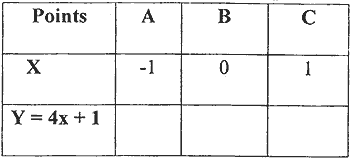
Question: 23. If x + 1/x = 3, find the value of x² + 1/x²
Question: 24. The dimensions of the cuboid are in the ratio 5:2:1. Its volume is 1250 cubic metres. What is its total surface area?
Question: 25. Construct a rhombus PQRS in which PQ = 7.5 cm, and ∠PQR = 80°.
Question: 26. The length, breadth and height of a hall are 12 m, 8 m and 10 m, respectively. The hall has a door of area 4 m × 1.5 m and a window of area 1.5 m × 1 m. Find the cost of painting the four walls at the rate of Rs. 100 per square meter.
Section D [4×6 = 24]
Question: 27. ABCD is a Rhombus. Find the values of x,y,z and also find AD if CB = 7 cm. Give reasons for your answer. (Refer to figure given)
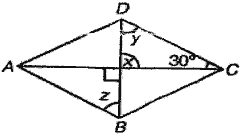
Question: 28. Simplify: (2a + 3b)³ + (2a – 3b)³. Mention the identities used.
Question: 29. Find the area of the following field. The measurements are in metres.
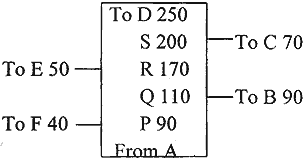
Question: 30. A well is dug 10 m deep and has a diameter of 1.4 m. The sand taken out is spread over a rectangular plot of dimension 11 m by 14 m to raise the level of the ground. What will be the height by which the ground is raised?
Question: 31. Construct a quadrilateral PQRS, given PQ = 6 cm, QR = 5.6 cm, Rs = 2.7 cm, ∠Q = 45° and ∠R = 90°. Mention the steps of construction.
Question: 32. The given graph describes the distances of a car from a city P at different times when it is travelling from City P to City Q, which are 350 km apart. Study the graph and answer the following:
- How far did the car go in the first hour?
- How much time did the car took to travel between 200 km to 350 km?
- Did the car stop for some duration at any place? Justify your answer.
- How much time will the whole journey take to reach city Q from P without stopping anywhere?
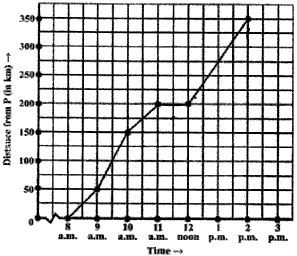
 Class Notes NCERT Solutions for CBSE Students
Class Notes NCERT Solutions for CBSE Students
